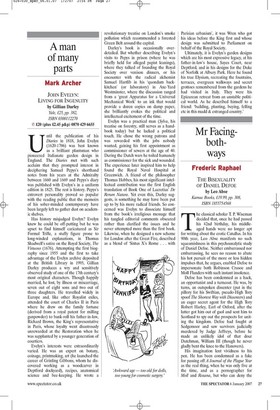A man of many parts
Mark Archer JOHN EVELYN: LIVING FOR INGENUITY by Gillian Darley Yale, £25, pp. 382, ISBN 0300112270 © £20 (plus £2.45 p&p) 0870 429 6655 Until the publication of his Diaries in 1818, John Evelyn (1620-1706) was best known as a brilliant plantsman who pioneered Italianate garden design in England. The Diaries met with such acclaim that they prompted interest in deciphering Samuel Pepys's shorthand notes from his years at the Admiralty between 1660 and 1669 and Pepys's diary was published with Evelyn's in a uniform edition in 1825. The rest is history. Pepys's extrovert personality proved so popular with the reading public that the memoirs of his sober-minded contemporary have been largely left to gather dust on academic shelves.
Has history misjudged Evelyn? Evelyn knew he could be off-putting but he was upset to find himself caricatured as Sir Formal Trifle, a stuffy figure prone to long-winded explanations, in Thomas Shadwell's satire on the Royal Society, The Virtuoso (1676). Attempting the first biography since 1955 and the first to take advantage of the Evelyn archive deposited at the British Library in 1995, Gillian Darley produces a wry and sensitively observed study of one of the 17th century's most original characters. Though happily married, he lost, by illness or miscarriage, seven out of eight sons and two out of three daughters. He travelled widely in Europe and, like other Royalist exiles, attended the court of Charles II in Paris where he drew on the family fortune (derived from a royal patent for milling gunpowder) to bank-roll his father-in-law, Richard Brown, the King's representative in Paris, whose loyalty went disastrously unrewarded at the Restoration when he was supplanted by a younger generation of courtiers.
Evelyn's interests were extraordinarily varied. He was an expert on botany, coinage, printmaking, art (he launched the career of Grinling Gibbons, whom he discovered working as a woodcarver in Deptford dockyard), recipes, anatomical science and bee-keeping. He wrote a revolutionary treatise on London's smoke pollution which recommended a forested Green Belt around the capital.
Darley's book is occasionally overdetailed. But whether describing Evelyn's visits to Pepys in prison (where he was briefly held for alleged papist leanings), where they talked of founding the Royal Society over venison dinners, or his encounter with the radical alchemist Samuel Hartlib in his 'quondam backkitchen' (or laboratory) in Axe-Yard Westminster, where the discussion ranged from a 'great Apparatus for a Universal Mechanical Work' to an ink that would provide a dozen copies on damp paper, she brilliantly evokes the political and intellectual excitement of the time.
Evelyn was a practical man (Sylva, his treatise on forestry, still serves as a handbook today) but he lacked a political touch. He chose the wrong patrons and was rewarded with the jobs nobody wanted, gaining his first appointment as commissioner of sewers at the age of 40. During the Dutch wars he toiled humanely as commissioner for the sick and wounded. The experience later inspired him to help found the Royal Naval Hospital at Greenwich. A friend of the philosopher Thomas Hobbes, his most significant intellectual contribution was the first English translation of Book One of Lucretius' De Rentm Natura. Yet even this, Darley suggests, is something he may have been put up to by his more radical friends. So concerned was Evelyn to dissociate himself from the book's irreligious message that his tangled editorial comments obscured rather than clarified the issues and he never attempted more than the first book. Likewise, when he designed a new scheme for London after the Great Fire, described as a blend of 'Sixtus X's Rome . . . with Parisian urbanism', it was Wren who got his ideas before the King first and whose design was submitted to Parliament on behalf of the Royal Society.
Ultimately, it is Evelyn's garden designs which are his most expressive legacy, at his father-in-law's house, Sayes Court, near Deptford, and in his designs for the Duke of Norfolk at Albury Park. Here he found his true Elysium, recreating the fountains, terraces, evergreen walkways and secret grottoes remembered from the gardens he had visited in Italy. They were his Epicurean retreat from an unstable political world. As he described himself to a friend: 'building, planting, buying, felling etc in this madd & estranged country.'




































 Previous page
Previous page